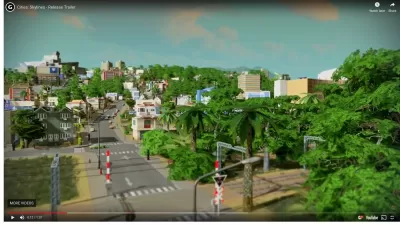The video game has inspired many people to pursue careers in planning. But, the newest version is also trying to better align the simulations with what planners face in the real world.

Jessica Roy writes about the history and influence of SimCity, the urban planning simulation game first released in 1989:
For many urban and transit planners, architects, government officials and activists, "SimCity" was their first taste of running a city. It was the first time they realized that neighborhoods, towns and cities were things that were planned, and that it was someone's job to decide where streets, schools, bus stops and stores were supposed to go.
While SimCity lead many planners into the field, the game has been criticized for creating worlds that do not reflect reality. The cities do not have bike lanes or mixed-use developments and, in the past, did not have parking. In addition, the options and solutions are oversimplified, say critics. "To lower crime rates, build police stations. If people complain about traffic, build more roads. If you need space to build a freeway or a stadium, raze working-class neighborhoods," says Roy.
The most recent iteration, an app called "SimCity: BuildIt" released in 2014, tries to address some of the limitations of earlier versions. The architecture and topography are more diverse, and some of the buildings include visible parking. "You can play a 'Green City' map in which residents have urban gardens and there's less pollution. Solar power is now an option," notes Roy.
FULL STORY: From video game to day job: How ‘SimCity’ inspired a generation of city planners

Planetizen Federal Action Tracker
A weekly monitor of how Trump’s orders and actions are impacting planners and planning in America.

Congressman Proposes Bill to Rename DC Metro “Trump Train”
The Make Autorail Great Again Act would withhold federal funding to the system until the Washington Metropolitan Area Transit Authority (WMATA), rebrands as the Washington Metropolitan Authority for Greater Access (WMAGA).

The Simple Legislative Tool Transforming Vacant Downtowns
In California, Michigan and Georgia, an easy win is bringing dollars — and delight — back to city centers.

Albuquerque’s Microtransit: A Planner’s Answer to Food Access Gaps
New microtransit vans in Albuquerque aim to close food access gaps by linking low-income areas to grocery stores, cutting travel times by 30 percent and offering planners a scalable model for equity-focused transit.

This City Will Pay You to Meet Your Neighbors
A North Kansas City grant program offers up to $400 for residents to throw neighborhood block parties.

Commentary: Our Silence Will Not Protect Us
Keeping our heads down and our language inoffensive is not the right response to the times we’re in. Solidarity and courage is.
Urban Design for Planners 1: Software Tools
This six-course series explores essential urban design concepts using open source software and equips planners with the tools they need to participate fully in the urban design process.
Planning for Universal Design
Learn the tools for implementing Universal Design in planning regulations.
Smith Gee Studio
City of Charlotte
City of Camden Redevelopment Agency
City of Astoria
Transportation Research & Education Center (TREC) at Portland State University
US High Speed Rail Association
City of Camden Redevelopment Agency
Municipality of Princeton (NJ)





























